
Litoria is a genus of hylid tree frogs, sometimes collectively referred to as Australasian treefrogs.
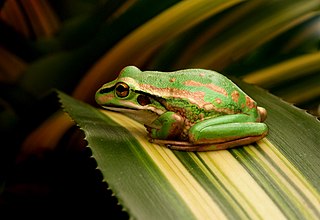
The green and golden bell frog, also named the green bell frog, green and golden swamp frog and green frog, is a species of ground-dwelling tree frog native to eastern Australia. Despite its classification and climbing abilities, it does not live in trees and spends almost all of its time close to ground level. It can reach up to 11 cm (4.5 in) in length, making it one of Australia's largest frogs.

The eastern dwarf tree frog, also known as the eastern sedge-frog, is a species of tree frog. It is a small and very common frog and found on the eastern coast of Australia, from around Cairns, Queensland, to around Ulladulla, New South Wales. Individual frogs of this species are often found elsewhere, having been accidentally relocated by transported fruit boxes. Confirmed sightings of breeding pairs have confirmed their survival in Victoria's cooler climate.
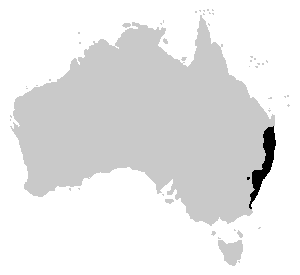
The robust bleating tree frog, also known as Keferstein's tree frog, is a species of tree frog in the subfamily Pelodryadinae. This frog is endemic to coastal eastern Australia, where it ranges from northeastern New South Wales to the NSW/Queensland border. It has also been introduced to Lord Howe Island.

The spotted grass frog or spotted marsh frog is a terrestrial frog native to Australia. It is distributed throughout all of New South Wales and Victoria, eastern South Australia, the majority of Queensland, and eastern Tasmania. It is also naturalised in Western Australia, having been unintentionally introduced at Kununurra in the 1970s, apparently during the relocation of several hundred transportable homes from Adelaide.

The Jervis Bay tree frog, also known as the curry frog in reference to its odour, is a species of Australian frog associated with wallum swampland along the east coast of New South Wales; ranging from the Queensland border to eastern Victoria.

The Blue Mountains tree frog also called the variegated river tree frog is a species of tree frog in the subfamily Pelodryadinae. It is endemic to southeastern Australia and is found in eastern Victoria and in southeastern New South Wales. The Jenolan Caves tree frog, a population formerly separated as Litoria jenolanensis, is nowadays included in this species.

The leaf green tree frog is a species of stream-dwelling frog, native to eastern Australia from the Queensland/New South Wales border south to Sydney.

The whistling tree frog (Litoria verreauxii), or Verreaux's tree frog, is a species of frog found in Australia. It has been divided into two subspecies, the nominate Verreaux's tree frog and the Verreaux's alpine tree frog. The alpine tree frog is restricted to the southern alps of New South Wales and Victoria. Verreaux's tree frog is widespread throughout south-eastern Queensland, coastal and highland regions of New South Wales, and south-eastern Victoria.
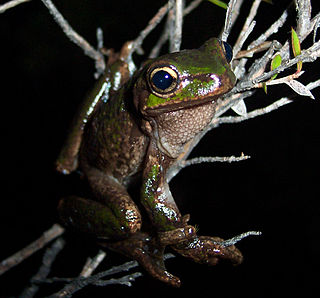
The Tasmanian tree frog, also known as king tree frog, is a species of tree frog that is found on the west coast of Tasmania, Australia. It was first found by Myrtle Burrows in 1941, at Cradle Mountain and handed over to Scott Oswald, who is attributed with the discovery.
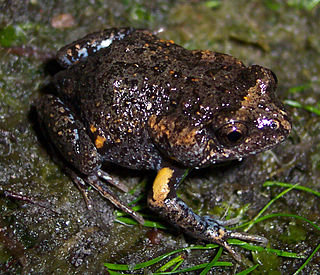
Tyler's toadlet is a species of ground frog that is found in coastal areas in southern New South Wales and eastern Victoria.
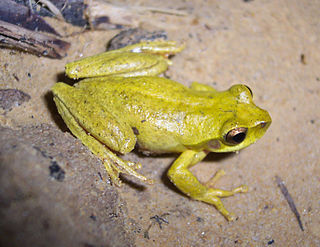
The revealed frog, whirring tree frog, or orange-thighed treefrog is a species of tree frog native to coastal eastern Australia.

The southern brown tree frog, also known as the brown tree frog, whistling tree frog, or Ewing's tree frog, is a species of tree frog native to Australia: most of southern Victoria, eastern South Australia, southern New South Wales from about Ulladulla—although this species is reported to occur further north—and throughout Tasmania including the Bass Strait Islands, in which state it is the most frequently encountered frog. It has been introduced to New Zealand, where it can be locally abundant.

The mountain stream tree frog is a species of tree frog native to highland areas of NSW, Australia stretching from the Myall Lakes area, north to around Dorrigo National Park and west to Barrington Tops National Park.

The Booroolong frog is a species of stream-dwelling frog native to the Great Dividing Range in New South Wales, Australia. It is a member of the Hylidae, or the "tree frog" family. The Booroolong frog is classified by the IUCN as a Critically Endangered Species.

The motorbike frog is a ground-dwelling tree frog of the subfamily Pelodryadinae found in Southwest Australia. Its common name is derived from the male frog's mating call, which sounds similar to a motorbike changing up through gears; it is also known as Moore's frog, the western bell frog, western green and golden bell frog, and western green tree frog. The Noongar name for it is Kyooya.Note 1
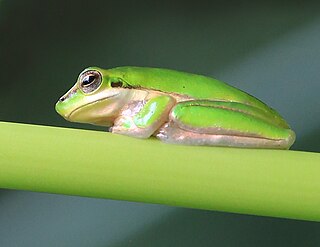
The northern dwarf tree frog is a small species of tree frog native to northern Australia, from the Kimberly region of Western Australia to Bowen, Queensland, and Aru Islands of Indonesia.

The long-thumbed frog, Fletcher's frog or barking marsh frog is a species of non-burrowing ground frog native to south-eastern Australia. The species belongs to the genus Limnodynastes. The twelve species in the genus are characterised by a lack of toe pads. Following phylogenetic analysis, the species was placed in L. peronii clade group alongside L. depressus, L.tasmaniensis and L. peronii.
Watson's tree frog, also known as the large brown tree frog or southern heath frog, is a species of tree frog endemic to south-eastern Australia.

The screaming tree frog is a species of frog in the subfamily Pelodryadinae. It is endemic to southeastern Australia, east of the Great Dividing Range. It ranges from northeastern Victoria to the mid-coast of New South Wales, from Mallacoota north to Taree. This species is the "bleating tree frog" that occurs around Sydney, and is well known for its very loud call.






















